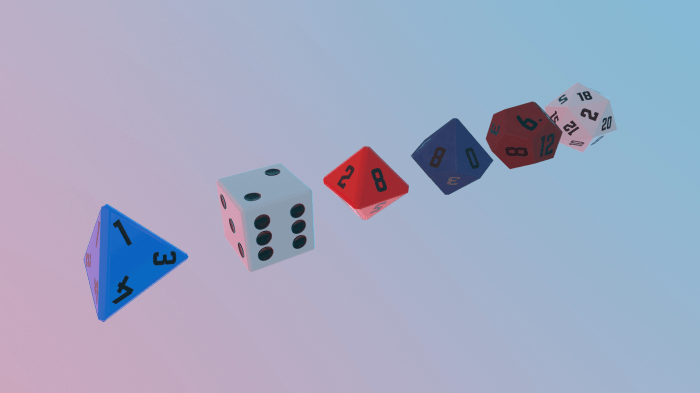
Roleplaying game dice sets are more than just colorful objects; they are the heartbeat of tabletop adventures. Each roll can determine the fate of heroes and villains alike, weaving intricate stories that players will remember long after the game concludes.
From the traditional d6 and d20 to more exotic polyhedral shapes, these dice come in various materials, colors, and designs, reflecting the personality of each player. Understanding their importance in gameplay mechanics not only enhances the gaming experience but also deepens the connection to the worlds we explore.
Overview of Roleplaying Game Dice Sets
Roleplaying games (RPGs) provide players with the opportunity to engage in adventures through storytelling and strategic gameplay, which often heavily relies on a variety of dice. Each type of die serves a unique purpose in determining outcomes, and their significance in gameplay mechanics cannot be overstated. Understanding the different types of dice used and the materials involved in their production can enhance the gaming experience.Various types of dice are utilized in RPGs, each serving distinct functions in gameplay.
The most common is the d6 (six-sided die), but other polyhedral dice such as d20 (twenty-sided die), d4 (four-sided die), d8 (eight-sided die), and d12 (twelve-sided die) are also prevalent. Each die contributes differently, affecting the probability of outcomes during gameplay. For example, the d20 is primarily used for attack rolls and skill checks, where higher numbers often indicate success.
In contrast, lower-sided dice like the d4 may determine damage in specific attacks or spell effects.
Types of Dice Used in RPGs
Different dice types each have unique roles that affect gameplay. Here’s a closer look at some of the most popular dice used in RPGs:
- d20: The cornerstone of many RPG systems, the d20 is used for nearly every action resolution, from combat to skill checks.
- d12: Often used for damage rolls in specific systems, a d12 can create significant variability in combat outcomes.
- d10: Commonly used in systems that involve percentage rolls, providing a range of outcomes from 1 to 100.
- d8: Frequently used for damage rolls and certain spells, the d8 provides a middle ground in variability.
- d6: The most universal die, often used in traditional tabletop games, it can be used for both damage rolls and other game mechanics.
- d4: Generally used for lower damage rolls or effects, this die adds a unique dimension to gameplay.
Significance of Dice in Gameplay Mechanics
Dice are vital for introducing randomness and chance into RPGs, which adds excitement and unpredictability to the gaming experience. The outcomes determined by dice rolls can influence character actions, story directions, and player strategies. The randomness of dice rolls ensures that no two sessions are ever identical, keeping players engaged and invested in their character’s journey.
Materials Used in the Production of Dice Sets
The materials used in crafting dice sets have evolved significantly over time, impacting both their aesthetics and gameplay. Players often prefer certain materials for their tactile feel and visual appeal. Here are some commonly used materials in dice production:
- Acrylic: A popular choice for its affordability and versatility, acrylic dice can come in a myriad of colors and designs.
- Resin: Often used for premium dice, resin allows for intricate designs and often incorporates inclusions like glitter or gemstones.
- Metal: For a more durable option, metal dice are heavier and provide a distinctive feel, making them a favorite among collectors.
- Wood: Wooden dice offer a rustic charm and can be crafted from various types of wood, giving each die a unique character.
The choice of material not only influences the aesthetics of the dice but also their weight and durability, which can enhance the overall gaming experience.
Collecting and Customizing Dice Sets

Collecting dice sets has become a popular hobby among tabletop gamers and enthusiasts alike. The allure of unique designs and thematic elements in dice can transform a standard gaming experience into a personalized adventure. This section explores techniques for collecting and displaying unique dice sets, alongside the exciting process of customizing them to reflect individual styles.Collecting dice is not just about quantity; it’s also about quality and uniqueness.
Many collectors enjoy the hunt for rare or limited edition sets, often looking for those with intricate designs or specific themes. Displaying these collections can also be a form of art, showcasing the vibrant colors and craftsmanship that each set offers.
Techniques for Collecting and Displaying Unique Dice Sets
Building a dice collection can be an enjoyable journey, with various techniques to enhance both the collecting and displaying experience. Here are some popular methods:
- Join Online Communities: Engaging with communities on platforms like Reddit or dedicated Facebook groups can provide insights on where to find unique dice.
- Attend Conventions: Events such as gaming conventions often feature vendors selling exclusive and custom dice that cannot be found elsewhere.
- Explore Artisan Dice Makers: Many artisans create custom dice, often featuring unique materials like wood or resin combined with stunning colors.
- Display Cases: Investing in display cases or shadow boxes can help showcase your collection beautifully while protecting the dice from damage.
- Custom Trays: Using custom dice trays not only adds flair to gameplay but also serves as a great way to display your dice when not in use.
Collecting dice is as much about the thrill of the hunt as it is about the final collection, making each find a story worth sharing.
Process of Customizing Dice
Customization allows players to create dice that reflect their personalities and gaming styles. The process generally involves selecting colors, materials, and even engraving options to produce truly one-of-a-kind pieces.
- Color Selection: Many companies offer a range of colors, from classic transparent options to vibrant, marbled effects. This allows collectors to choose hues that match their gaming theme or personal aesthetic.
- Engraving Options: Personalized engravings can include names, logos, or special symbols, making the dice not just tools for gameplay but treasured items.
- Material Choices: Different materials, such as metal, resin, or acrylic, can also be chosen based on the desired weight and feel of the dice.
- Themed Sets: Many players opt for themed sets that correlate with their character or campaign, such as dice inspired by fantasy realms, technology, or nature.
Customization can elevate the gaming experience by adding a personal touch to the player’s arsenal.
Examples of Unique Dice Designs and Their Themes
The world of dice design is rich with creativity, often leading to breathtaking pieces that capture the imagination. Here are some notable examples of unique dice designs and their themes:
- Galaxy Dice: These dice are infused with swirling colors reminiscent of galaxies, often featuring speckles of glitter to emulate stars.
- Wooden Dice: Crafted from various types of wood, these dice can embody rustic themes, complete with etched designs that highlight the natural grains.
- Elemental Dice: Each set might represent one of the elemental forces — Earth, Fire, Water, or Air — with colors and engravings that reflect these themes.
- Mythical Creatures: Dice themed around dragons, unicorns, or other legendary beings often include intricate carvings and vivid colors associated with those creatures.
These unique designs not only enhance gameplay but also serve as conversation starters, reflecting the diverse interests of the gaming community.
The Role of Dice in Various Gaming Categories
Dice serve as a fundamental component in a variety of gaming genres, each utilizing them in unique ways to enhance gameplay and introduce elements of chance. Their role can vary significantly depending on the game’s mechanics and overall design. From roleplaying games to board games, and even in various forms of digital gaming, the use of dice adds depth and unpredictability to the experience.
Comparison of Dice Use in Roleplaying Games and Board Games
Roleplaying games (RPGs) and board games both incorporate dice, but their functions and impacts differ. In RPGs, dice are often employed to determine the outcomes of character actions, such as combat or skill checks, heavily influencing the narrative and player experience. Players might roll a twenty-sided die (d20) to determine if their character successfully performs a heroic feat. This introduces an element of unpredictability, fostering a rich storytelling atmosphere.In contrast, board games may use dice primarily to dictate movement or resource allocation.
For instance, in a game like “Monopoly,” players roll two six-sided dice to move around the board, impacting their strategic decisions but generally keeping the focus on game mechanics rather than narrative development. The reliance on chance in board games tends to be more about competition rather than collaborative storytelling found in RPGs.
Differences in Dice Mechanics Between Card Games and Video Games
Card games and video games incorporate dice mechanics differently, reflecting their unique gameplay environments. In card games, dice can serve to introduce randomness in drawing cards or influencing play order. An example of this is found in games like “Dice Masters,” where dice complement card abilities, adding a layer of strategic depth as players must manage both their cards and dice rolls.Video games, however, often abstract the role of dice through programmed algorithms that simulate randomness.
Games like “Borderlands” use dice-like mechanics, such as loot generation and encounter outcomes, but the player never physically rolls dice. The randomness is controlled by the game’s engine, allowing for a consistent, albeit unpredictable, experience that is influenced by player actions rather than physical dice.
Other Games Where Dice Play a Crucial Role
Dice mechanics extend beyond traditional tabletop gaming into various other formats, including arcade and online games. In arcade games, titles like “Craps” directly integrate dice rolls as a core gameplay mechanic, where players bet on the outcome of the dice. The physicality of rolling the dice in a lively environment adds excitement and a sense of community among players.Online games also leverage dice mechanics, often in ways that mimic tabletop experiences.
For instance, games like “Dungeons & Dragons Online” allow players to roll virtual dice to determine the outcomes of in-game actions, maintaining the immersive feel of traditional RPGs while utilizing digital interfaces. This integration of dice into diverse gaming categories highlights their versatility and significance in enhancing gameplay across the board.
Dice not only determine fate but also enrich the gaming experience by providing unpredictability and strategy.
Outcome Summary

In conclusion, roleplaying game dice sets are essential tools that add depth and excitement to gaming sessions. Whether you’re collecting unique sets or customizing them to fit your theme, these dice serve as a bridge that connects players to their adventures, embodying the spirit of creativity and chance that defines roleplaying games.
Essential Questionnaire
What types of dice are commonly used in roleplaying games?
Common types include d4, d6, d8, d10, d12, and d20, each serving different purposes in gameplay.
Can I customize my dice?
Yes, many companies offer customization options for colors, engravings, and materials.
Are there specific dice for different RPG systems?
Yes, some RPG systems may require specific dice or combinations of dice to handle their unique mechanics.
How can I display my dice collection?
Creative display cases, dice trays, or shadow boxes are great ways to showcase unique dice sets.
What materials are dice made from?
Dice can be made from plastic, resin, metal, and even wood, each offering distinct aesthetics and durability.





